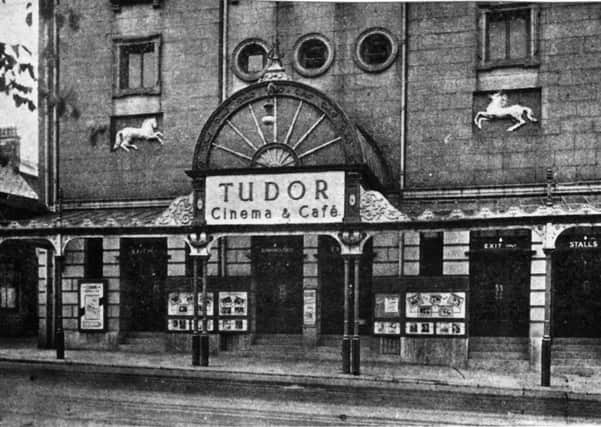Nostalgia on Tuesday: A life in pictures


Huddersfield people first saw animated pictures on September 21, 1896 in a huge wooden building dating from 1887. The venue, Rowley’s Empire Theatre, at the Byram Street/St Peter’s Street corner, was erected by JW Rowley with accommodation for almost 3,000 people. Images were projected on to a white sheet via a Theatregraph and the process was described by the Huddersfield Daily Chronicle the following day: ‘On a long vellum of Kodak gelatine, very transparent, a print is taken of from 600 to 800 photographs, each about the size of a penny stamp. They are executed at the average rate of 15 per second, and the succession of pictures (as they are thrown on to the screen at the same rate) is so rapid that the retina of the eye is scarcely able to distinguish between them, with the result that the scene depicted passes before the spectator with all the realism of life’. The animated pictures showed a steamship leaving a pier, a train arriving at a station and the finish of the Prince of Wales’s ‘Derby’.
Thereafter, moving pictures were shown at the Town Hall, Corporation Street, from May 4, 1898 via an American ‘Veriscope’ and at a number of other venues including the Victoria Temperance Hall from May 31, 1898; the Armoury, Ramsden Street, March 20, 1900; the Palace Theatre, Kirkgate, 1909; the Picturedrome, Buxton Road, December 2, 1910; Post Office Picture Hall, Byram Street, Boxing Day 1910; Olympia, Viaduct Street, October 21, 1912.
Advertisement
Hide AdAdvertisement
Hide AdThe Cinematograph Act introduced in January 1910 put safety high on the agenda and encouraged the construction of purpose-built cinema houses to comply with new rules. Huddersfield’s first, the Picture House in Ramsden Street, opened on December 26, 1912. Designed by AC Haig, the owners were the Northern Theatre company of Halifax. Seating was for 600 and initially admission prices ranged from 3d to one shilling. The screen measured 17ft by 15ft and the first films shown were The Indelible Stain and The Red Ink Tragedy.
Before the First World War nearly all UK towns boasted a picture house. In Huddersfield, cinema numbers continued to grow. The Palladium opened in Blacker Road, Birkby, on March 16, 1913. J Hall & Sons of Huddersfield designed the building for the proprietor the Palladium Picture Company (Birkby) with seating for 500. During hostilities, two more cinemas opened. The Empire Picture House, John William Street, greeted patrons on March 8, 1915; the stalls and a single balcony provided seating for 800. The Excelda Cinema in Lockwood Road opened on November 18, 1915.
Prior to the first ‘talkie’ film being shown in Huddersfield in 1929, a few more cinemas had sprung up. Among these were the Savoy, Westbourn Road, February 19, 1920; Grand Picture Theatre, March 14, 1921; Premier Picture House, Paddock Head May 31, 1922; the Lyceum, Wakefield Road February 6, 1922 and the Princess Picture House, Northumberland Street, May 19, 1923.
Two films, The Jazz Singer and The Singing Fool, screened in 1928, established the trend of talking pictures in Britain. The Picturedrome screened Huddersfield’s first full length talkie – The Donovan Affair – from July 8, 1929. The 1930s witnessed several large organisations taking hold of the cinema industry including the Gaumont – British Picture Corporation, Associated British Cinemas (ABC) and Odeon.
Advertisement
Hide AdAdvertisement
Hide AdOne of Huddersfield’s most impressive cinemas, the Ritz, welcomed patrons on February 10, 1936. Costing about £100,000 to complete, it included a proscenium about 50 feet wide and a 28 feet deep stage with seven dressing rooms. There was also a £10,000 Wurlitzer organ. Seating in the stalls and circle was for 2,036, and adjacent at circle level was a cafe.
Further cinema developments continued unabated for the remainder of the decade. The Lounge, Newsome Road, designed by architect Joe Ainley, opened on December 15, 1937. Designed by JH Freer, the Rialto Cinema, Sheepbridge, began screening in November 1938. A formal opening was attended by Councillor and Mrs James R Gregson, along with Joan Ellum who featured in the opening film South Riding.
On the outbreak of war in September 1939, cinemas closed down but large numbers reopened a week or two later, as it was agreed entertainment could boost morale.
Programmes were sometimes interrupted due to aerial bombardment and an absence of men meant many women were trained to work in the projection box.
Advertisement
Hide AdAdvertisement
Hide AdA number of severe factors brought about a steady decline in cinema attendances during the early 1950s: the revival of other leisure activities after the war and the rise in the number of people watching black-and-white BBC television.
Many cinemas found other leisure uses. Others suffered a long drawn-out fate, boarded up and derelict before the inevitable demolition.
One cinema, the Empire, has gained listing status and reflects the higher points of the industry’s glory days in Huddersfield.
Special thanks to the Cinema Theatre Association for help with this piece. Readers may also consult Ninety Years of Cinema in Huddersfield by Brian Hornsey.